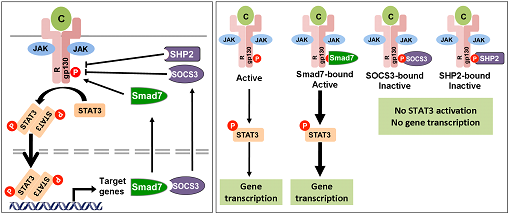Dr. Xin-Hua Feng’s group published a research article entitled “Smad7 enables STAT3 activation and promotes pluripotency independent of TGF-β signaling” on PNASon September 5, 2017.
TGF-β and related growth factors critically regulate cell potency and functions. Smad7 is a negative feedback product of TGF-β superfamily signaling and fine-tunes a plethora of pleiotropic responses induced by TGF-β ligands. However, its non-canonical functions independent of TGF-β signaling remain to be elucidated. In this study, Dr. Feng’s group reported that Smad7 activates STAT3 signaling in maintaining mouse embryonic stem cell (ESC) pluripotency in a manner independent of the TGF-β signaling pathway yet dependent of the LIF co-receptor gp130. Smad7 directly binds to the intracellular signaling domain of gp130 and disrupts the SHP2-gp130 or SOCS3-gp130 complex, thereby amplifying STAT3 activation. Consequently, Smad7 facilitates LIF-mediated self-renewal of mouse ESC and is also critical for induced pluripotent stem cell (iPSC) reprogramming. This finding illustrates an uncovered role of the Smad7-STAT3 interplay in maintaining cell pluripotency, and also implicates a mechanism involving Smad7 underlying cytokine-dependent regulation of cancer and inflammation.

A working model for Smad7 potentiating STAT3 activation
Link: http://www.pnas.org/content/early/2017/09/01/1705755114.full



